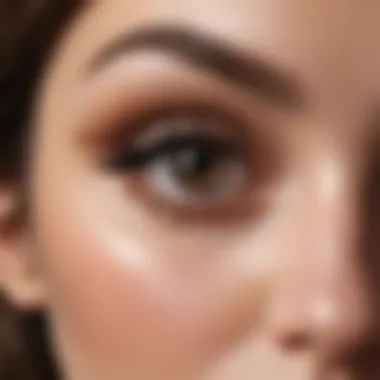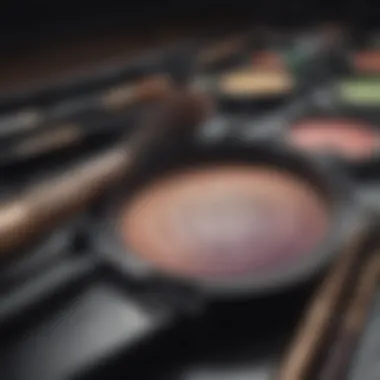Essential Eyeshadow Brushes for Makeup Beginners


Intro
Diving into the world of makeup can feel like navigating a maze, especially for beginners. The variety of tools available, specifically eyeshadow brushes, can be overwhelming. Understanding these brushes is crucial to mastering eyeshadow application. The right brushes can elevate your skills and bring your makeup vision to life.
From blending colors seamlessly to achieving dramatic effects, each brush serves a unique purpose. This narrative aims to demystify the essential eyeshadow brushes that every makeup enthusiast should consider. With practical advice and expert insights, we’ll cover types of brushes, their specific uses, and how to maintain them, ensuring that your journey into the world of eyeshadow is both enjoyable and successful.
Understanding Eyeshadow Brushes
In the world of makeup, eyeshadow brushes play a pivotal role. They are not just tools; they are extensions of an artist’s vision. Every brush serves a specific purpose, and understanding these tools greatly enhances the application process. For beginners, knowing the differences among various brushes can prevent frustration and save time as one navigates the colorful realm of makeup. It’s a bit like putting the right key in the right lock; if you don’t have the appropriate brush, achieving that coveted look can feel out of reach.
The Importance of Choosing the Right Brush
When it comes to eyeshadow application, the right brush can make all the difference. A poor choice not only impacts the final look but can also affect the application technique. Imagine trying to paint a delicate landscape with a wide-bristled brush meant for ceilings; the results won’t be pretty.
- Precision - Each brush is designed for specific functions. For example, a flat shader brush is great for packing color onto the eyelid, while a blending brush is tailored for seamlessly softening harsh lines. Using the right brush ensures you create the look you desire without excessive effort.
- Texture - Different brushes can manipulate colors and textures in unique ways. Natural bristles tend to pick up more product, which is great for rich pigments, while synthetic brushes often excel at applying creamy products. This choice can significantly influence the look you achieve.
- Comfort and Control - The better the grip and control you have over a brush, the more confident and precise your application will be. A well-weighted brush allows for effortless control during application, leading to smoother results.
"Choosing the right brush transforms your eyeshadow game from mere application to a work of art."
Ultimately, understanding eyeshadow brushes isn't just a luxury; it's a necessity for anyone aiming to refine their makeup skills. A judicious selection not only lays the foundation for better application but also enhances creativity.
In short, when embarking on your makeup journey, take the time to grasp the fundamentals of these essential tools. The brushes you select today will directly shape your artistry tomorrow.
Types of Eyeshadow Brushes
Diving into the world of eyeshadow brushes reveals a plethora of options, each serving distinct purposes that cater to every makeup enthusiast, especially those just starting. It’s important to understand these different types, as each brush type is designed to achieve specific results and effects. Having the right brush for the job can mean the difference between a flawless look and a makeup mishap. Not only does it enhance the application process, but it can also optimize the product performance, thus ensuring that beginners can express themselves without frustration.
Flat Shader Brushes
Flat shader brushes are possibly the most recognizable in a makeup kit. They typically have dense, short bristles that are flat and rectangular in shape. This design allows for a precise application of eyeshadow onto both the eyelid and brow bone, making them invaluable for packing on color. These brushes are excellent for applying pigment-heavy shades, especially shimmers and metallics, enhancing the vibrancy of the pigment.
Using a flat shader brush, especially when dampened slightly, can yield results that are rich and bright. Many beginner artists often find the transition from pan to eye seamless with this kind of tool, reducing the chances of fallout. The firmness of the bristles provides the control necessary to avoid uneven patches, making it a staple brush for anyone starting their makeup journey.
Blending Brushes
Every makeup enthusiast knows that blending is key to a polished eyeshadow look. Blending brushes generally feature soft, fluffy bristles that help to soften lines and create a seamless transition between colors. Whether it’s for softening harsh edges or creating dimension, a good blending brush is essential.
These brushes come in various shapes and sizes; some are more tapered for detailed work, while others are larger for broad blending. When working with multiple shades in a look, applying a transitional shade with a blending brush helps to achieve a gradient effect. This is especially useful for beginners learning to recreate more complex eye looks, as it allows them to experiment while reducing the chances of looking overly made up.
Detail Brushes
Detail brushes are the unsung heroes in an eyeshadow brush collection. These brushes are smaller and more precise, making them ideal for intricate work. If a beginner wants to create a defined eyeliner effect or add eyeshadow to the lower lash line, a detail brush is suitable for the task.
Typically, these brushes have a fine tip, allowing for the application of eyeshadow in small areas without veering off into unwanted territory. They are also fantastic for applying highlight to the inner corner of the eyes or on the brow bone, giving that professional touch even to the simplest of looks.
Crease Brushes
Crease brushes are specially shaped to fit into the crease of the eyelid, providing dimension to the eyes. With their slightly tapered heads, they allow for easy application of darker shades that help to add depth and enhance one's natural eye shape. Using a crease brush can help beginners create definitions and shadows effortlessly.


Its design aids in controlling the application so you avoid the dreaded “raccoon look.” Instead, you can achieve a soft and blended crease, which is crucial for many eye makeup looks.
Bonus: Specialty Brushes
Beyond the standard brushes, there’s an enticing world of specialty brushes that cater to specific needs. Specialty brushes include tools like fan brushes for highlighting, angled brushes for liner application, or even concealer brushes that can help with covering imperfections. These brushes, while not necessary for every beginner, can add a unique flair to one’s makeup routine.
For instance, a fan brush can deliver a beautiful light dusting of highlighter for a natural glow. Meanwhile, an angled brush can create a winged liner with precision. Investing in a few of these can elevate the makeup experience and offer more creative outlets as one’s skills develop.
"Choosing the right brush is like having the right paintbrush for the masterpiece you're about to create."
Understanding the types of brushes available not only assists in makeup application, but also inspires creativity. Each brush type carries the potential to unleash artistry that suits everyday looks or glamorous occasions, making them fundamental tools for any aspiring artist.
Selecting Brushes for Beginners
When you step into the world of eyeshadow application, selecting the right brushes can make or break your entire look. For beginners, this can feel daunting, but understanding your personal needs and preferences can simplify the process significantly. You want tools that are not just good quality but also tailored to suit your unique style. This section will guide you through assessing what you need, the budget you should consider, and whether synthetic or natural materials best serve your makeup goals.
Assessing Personal Needs
Before you even think about purchasing, take a moment to reflect on your makeup habits and the looks you’re aiming for. Do you want a subtle everyday appearance, or are you leaning toward bold, colorful eyes? Knowing your desired style will guide you in selecting your brushes.
- Usage Frequency: If you plan to experiment with various looks, opt for a range of brushes. A basic set typically includes a flat shader, a blending brush, and a crease brush, essential for versatile application.
- Complexity of Application: Assess how complex you want your makeup to be. If intricate designs and detailed work intrigue you, a couple of detail brushes are invaluable. Likewise, for those who prefer simplicity, a few well-chosen brushes will suffice.
- Control and Proficiency: Think about how comfortable you are with makeup. If you're a novice, tools that offer more control, like dense brushes, help build confidence. As your technique improves, you may find yourself craving more specialized brushes.
Budget Considerations
Many people let budget constraints dictate their choices, but it's essential to strike a balance between cost and quality. You might be tempted to grab a cheap set, but often, these brushes don’t perform well and can ruin your makeup experience. Instead, consider a few key points:
- Invest Wisely: It’s better to buy one high-quality brush than to collect multiple subpar ones. Brands known for their durability and performance will often cave out some cash, but they’ll last longer in your toolkit.
- Scale Gradually: If the budget is tight, consider purchasing brushes one at a time. Start with essentials like a good blending brush and then build your collection from there.
- Look for Sales or Sets: Many retailers offer bundles which provide savings. An eyeshadow brush set can deliver the tools you need at a more reasonable price than buying each piece individually.
Material Choices: Synthetic vs Natural
The material of your brushes can significantly affect both application and upkeep. Understanding the differences between synthetic and natural fibers helps in making the right choice based on your personal preferences and the needs of your skin.
- Synthetic Brushes: Generally made of nylon or polyester, these brushes are often easier to clean and maintain. They are ideal for those who use cream or liquid products, as the dense bristles can handle heavier textures. Additionally, synthetic fibers tend to be more animal-friendly, making them popular among those who prioritize ethical choices in beauty products.
- Natural Brushes: Made from animal hair, these brushes are highly favored for their ability to blend powder products effortlessly, giving a seamless finish. If you are mainly working with powder shadows, these might be the brushes you want. However, they require more care as the hairs can absorb oils and pigments over time, leading to eventual wear.
Important Note: Always check if the brushes are cruelty-free if animal welfare is a priority for you.
Essential Techniques for Beginners
Knowing how to properly use eyeshadow brushes can transform a simple makeup routine into a masterpiece. This section emphasizes the essential techniques beginners need to harness the power of their brushes, allowing them to achieve desired looks. Understanding these techniques is crucial, not only for enhancing one's skills but also for preventing mistakes that can lead to frustration and dissatisfaction.
Application Techniques for Different Brushes
When it comes to applying eyeshadow, the technique varies based on the type of brush being used. Each brush has its own design and intended purpose, which directly affects how the eyeshadow is applied.
- Flat Shader Brushes: Ideal for packing on color. To use, hold the brush flat against the eyelid and tap the eyeshadow directly onto your lid. This motion intensifies the pigment, ensuring that vibrant color makes its way onto your eyelid.
- Blending Brushes: These brushes create a seamless look. After placing your eyeshadow, use the blending brush in circular motions to soften the edges. This helps eliminate harsh lines and promotes a well-blended appearance.
- Detail Brushes: Use these for precision. Dip a detail brush into darker shades and apply them in the outer corners or along the lower lash line for a smokey effect. This technique adds depth and definition to the eyes.
Using these brushes correctly can speed up the application process while enhancing the overall aesthetic of your makeup.


Layering and Blending Techniques
Layering and blending play integral roles in achieving a polished eyeshadow look. Mastery of these techniques can elevate your makeup from basic to stunning.
- Layering: Begin with a light shade as a base across the lid, and then apply progressively darker shades as you move towards the crease. This technique creates dimension in your eye makeup. Apply the second layer lightly, gradually building up to your desired intensity.
- Blending: Once the layers are applied, blending cannot be overstated. It creates a more sophisticated transition between colors. For effective blending, use a clean blending brush and employ windshield wiper motions in the crease. Following this approach prevents any overly harsh transitions.
More often than not, beginners undervalue these techniques, focusing mainly on applying color rather than how they can make colors interplay beautifully. With practice, layering and blending can look effortless.
"Makeup is about balance. When the eyes pop, everything else should be calm."
By sharpening these essential techniques, you'll find that your confidence blooms alongside your skills. Remember, the world of makeup is vast and filled with opportunities to express creativity. Practicing these methods will undoubtedly enhance your overall makeup journey.
Maintaining Your Eyeshadow Brushes
When it comes to eyeshadow brushes, keeping them in top shape is arguably just as essential as choosing the right ones. Those little tools are your partners in crime for achieving that perfect eye look. If you neglect them, you might as well be painting with a raggedy old brush. Maintaining your eyeshadow brushes not only extends their lifespan but also ensures that your makeup application remains flawless. Here’s why it matters:
- Hygiene: Brushes gather dust, oils, and bacteria. Using dirty brushes could lead to skin irritations or breakouts.
- Performance: Clean brushes perform better. Product clumps on bristles can affect how well your makeup goes on—think uneven application.
- Investment Protection: Quality brushes aren’t cheap. Treating them well makes sure you get your money’s worth.
In this section, we will explore two primary aspects of brush maintenance: cleaning techniques and storage solutions.
Cleaning Techniques
To keep your brushes performing at their best, regular cleaning is non-negotiable. Not everyone may know the nuances of how to do it right, though. Here’s a simple approach:
- Gather Materials: You’ll need a gentle soap or brush cleaner, a bowl for rinsing, and a clean towel.
- Wet the Bristles: Splash warm water on the bristles, but avoid soaking the handle. Getting water in the ferrule can loosen the glue over time.
- Lather Up: Add a small drop of soap to your palm and swirl the brush bristles gently. Be cautious—too much pressure can ruin the shape of the brush.
- Rinse: Rinse thoroughly under lukewarm water until the water runs clear.
- Shake Off Excess Water: Don’t wring! Just shake the brush gently.
- Reshape and Dry: Lay brushes flat on a clean towel to dry. This helps keep their form intact.
These might sound simple, but diligent cleaning can have huge benefits.
"A clean brush is like a blank canvas—ready for whatever you want to create."
Storage Solutions
Once your brushes are clean and dry, how you store them is another part of the equation to ensure they last. Improper storage can lead to bent bristles or damage to the material. Here are a few effective methods for storing your brushes:
- Brush Holder or Stand: Using a holder designed specifically for brushes keeps them upright and organized. This minimizes wear on the bristles.
- Folded Cloth or Pouch: A simple cloth pouch can protect your brushes from dust and light damage. Just be sure they’re completely dry before tucking them away.
- Drawer Dividers: If you’re low on surface space, consider dividers in your makeup drawer to keep brushes separate from each other.
Consider your space and frequency of use when deciding on storage. A well-organized collection makes it easier to grab what you need and keeps you motivated to experiment with your looks.
By mastering these maintenance tips, your brushes will stay in prime condition, allowing you to enhance your artistry and possibly even impress yourself along the way!
Common Mistakes to Avoid
When embarking on the journey of mastering eyeshadow application as a beginner, avoiding common mistakes can make all the difference. These missteps not only hinder your progress but also lead to frustration and dissatisfaction with the results you achieve. Understanding these pitfalls is essential for establishing a strong foundation in makeup application. Here, we explore two key errors—selecting the wrong brush type and falling into poor cleaning habits—as well as the impact they can have on your makeup experience.
Selecting the Wrong Brush Type
Choosing the right brush type is vital when it comes to applying eyeshadow effectively. Many newcomers to the makeup world often find themselves drawn to brushes based on appearance or price rather than their intended purpose. This can throw a wrench into your makeup routine. For instance, using a blending brush to apply a bold, shimmery shade might lead to muddied colors and lackluster results. Conversely, picking a flat shader brush for blending will leave harsh lines and an unprofessional look.


In essence, knowing the functions of different brushes can save you a boatload of frustration and missed opportunities for creativity. For example, flat shader brushes are designed to pack on color, while blending brushes help diffuse shades for that dreamy gradient. Paying attention to how a brush is crafted can also help. Natural bristles might work wonders for powder shadows; synthetic ones can be perfect for cream formulas.
So how does one choose wisely? Taking the time to explore various brush options and aligning them with your vision for eyeshadow looks—be it smoky, bold, or subtle—might seem tedious at first. Yet, it's definitely worth its weight in gold when you see that final product reflecting your effort.
Poor Cleaning Habits
Equally as important as selecting the right type of brush is maintaining those brushes properly. Many beginners underestimate the significance of cleaning their tools, thinking a quick wipe or infrequent wash suffices. However, neglecting this vital step can breed bacteria, leading to skin irritations and unsatisfactory application of eyeshadows.
The first thing to know is how often brushes should be cleaned. Ideally, you should wash brushes that have been heavily used at least once a week. A gentle soap or brush cleaner can be effective, but never forget to rinse and lay them flat to dry to avoid water damage to the bristles. Some people might think that just spraying sanitizers can do the trick, but this can give a false sense of security. A deep clean with water and soap removes pigments and oils effectively, ensuring your tools remain in top shape.
Moreover, poor cleaning habits can lead to color transfer between your brushes. If you're using a brush that last held a deep brown shadow for your next soft pastel look, expect an unwanted surprise. Remember that a clean brush is a happy brush, and a happy brush helps you achieve the flawless looks you strive for.
"Keeping your brushes clean is like cleaning your workspace; it keeps both your tools and creativity flowing."
Expert Insights on Eyeshadow Brushes
Understanding the artistry that goes into makeup application hinges heavily on the choice of tools, especially when it comes to eyeshadow brushes. The guidance from professional makeup artists can illuminate the path for beginners, helping them avoid common pitfalls and enabling them to reach their full potential. This section delves into their recommendations and the latest trends in brush design, invaluable components for honing skills and enhancing creativity in makeup application.
Professional Makeup Artist Recommendations
When stepping into the realm of eyeshadow brushes, experienced artists often emphasize the significance of investing in quality. According to many seasoned professionals, not all brushes are created equal. A few commonly endorsed brushes include:
- Mac 217 Blending Brush: Esteemed for its versatility, this brush is a staple for seamless blending and perfect for various eyeshadow textures.
- Sigma E55 Eye Shading Brush: Noted for its ability to pack on color with precision, making it ideal for vibrant eyeshadow applications.
- Sephora Collection Pro Crease Brush #27: A go-to for its soft bristles and excellent control during crease work.
These brushes stand out not just for their functionality but for how they elevate the overall makeup application experience.
A common piece of advice echoed across the industry is the importance of layering tools. Artists suggest starting with a good blending brush before moving on to packing brushes, as this foundational technique creates depth and dimension in the eyeshadow look.
Trends in Brush Design
As the beauty landscape evolves, so do the tools that accompany it. Recent trends in brush design reflect a confluence of innovation and practicality.
- Ergonomic Handles: Increasingly, manufacturers are focusing on ergonomic designs, ensuring that brushes fit comfortably in the hand. This allows for better control and less strain during long application sessions.
- Sustainable Materials: With rising awareness around environmental issues, more brands are shifting towards synthetic materials that mimic natural hair while being cruelty-free. These alternatives offer similar performance and an easier cleaning routine.
- Dual-Ended Brushes: These multifunction tools are gaining popularity for their convenience, providing multiple applications in a single brush. This trend caters particularly to makeup enthusiasts looking to streamline their kits without sacrificing diversity.
"The right brush can make all the difference. It's like having the right instrument in a symphony." – Renowned Makeup Artist
As we gear up for the future of beauty, it's evident that the evolution of eyeshadow brushes will continue to pave new paths for creativity and artistry. Embracing these insights and trends, beginners can not only choose the right brushes but also understand the value these tools bring to their makeup artistry journey.
Culmination: Empowering Your Makeup Journey
Navigating the world of makeup can seem like a challenging endeavor, particularly for beginners. The journey into the realm of eyeshadow brushes is no exception. This article has hopefully illuminated the critical significance of choosing the right brushes, employing essential techniques, and understanding how to maintain your tools effectively. Knowing the ins and outs of these brushes enhances not just application techniques but also the artistry behind makeup itself.
The proper brush can truly transform your efforts from basic to extraordinary.
Encouragement to Experiment
When it comes to makeup, the only boundary is your imagination. Experimenting with various eyeshadow brushes may seem daunting at first, but it is fundamentally pivotal. Understanding how different brush types contribute to the overall result allows you to harness your unique style. Whether you're a fan of dramatic looks or prefer subtle shades, remember that each brush serves its purpose and by trying them all, you can find what fits your flair.
Every time you practice, you refine your skills. The brushes you select should cater to your preferences and the looks you're aiming for. Don't shy away from mixing brush styles or techniques to create that perfect blend. Learning by doing is the name of the game here.
Take note of your results, and adjust your approach as necessary. Maybe the flat shader brush you initially chose for the job feels too stiff – perhaps a softer one could yield different shades. You might even find that a blending brush works wonders in areas you least expected.
Stay dedicated to your experiments and observe the subtle differences different brush types make on your application methods.
"Creativity takes courage." - Henri Matisse
In the end, don’t be afraid to step out of your comfort zone; play with textures, colors, and products until you hit that sweet spot. Along this path, you will not only develop your technique but also discover what feels right for you. Embrace the learning curve, and remember that every expert was once a beginner. Your makeup journey is uniquely yours – get after it, and have fun!



